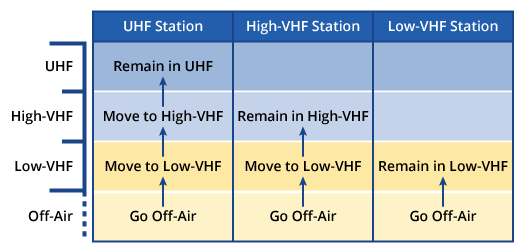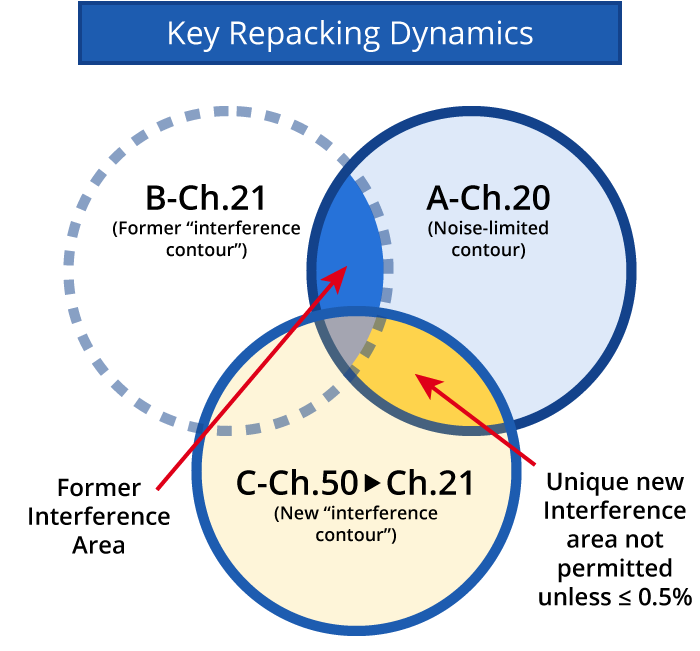Eligibility
Who's Eligible?
During the “reverse auction” phase of the incentive auction, eligible full power and Class A television licensees will have the unique financial opportunity to voluntarily return some or all of their spectrum usage rights in exchange for a share of the proceeds from a “forward auction” of new licenses to use the repurposed spectrum for mobile broadband services. Robust participation by broadcasters will be critical to the incentive auction’s overall success.
As mandated by the Spectrum Act, only full power (commercial and non-commercial) and Class A licensees as of the date of enactment of that Act are eligible to participate in the reverse auction. Licensees of Low Power Television and Television Translator stations will not be eligible to participate.
Consistent with the Spectrum Act, the Commission will protect the identity of licensees that apply to participate in the reverse auction. Specifically, the Commission will maintain the confidentiality of information submitted by all licensees that apply to participate until the results of the reverse auction and the repacking process are announced. The Commission will maintain the confidentiality of information from applicants that do not become winning bidders for an additional two years. Confidential information will include licensees’ names, channels, call signs, facility identification numbers, network affiliations, and any other information necessary to protect licensees’ identities.
Bidding
Bidding Options & Process
 Broadcasters will have four options to participate in the reverse auction, depending on their current channel assignment:
Broadcasters will have four options to participate in the reverse auction, depending on their current channel assignment:
- Bid to relinquish their license and go off the air;
- Bid to relinquish their current channel in order to share a channel with another broadcaster after the auction; or
- Bid to relinquish a UHF channel to move to either a high VHF (7 to 13) or low VHF (2 to 6) channel;
- Bid to relinquish a high VHF channel to move to a low VHF channel.
Each of these options involves different business and strategic tradeoffs and are designed to make the auction accessible to the widest possible range of broadcaster participants. Of course, a broadcaster may choose not to participate in the auction and to continue broadcasting on the same band (UHF, high VHF or low VHF), subject to potential channel reassignment resulting from the repacking process.
The Commission adopted a "descending clock" format for the reverse auction. In each bidding round, stations will be offered prices for one or more bid options and will indicate their choices at these prices. The prices offered to each station for options will be adjusted downward as the rounds progress in a way that accounts for the availability of television channels in different bands in the repacking process. Once there is no feasible channel to repack a participating station, its price offer is frozen and the station is a provisionally winning bidder. A station may drop out of the auction at any round. The reverse auction ends when all stations have either dropped out or are frozen. If the final stage rule is satisfied in that stage, then the frozen stations are named as the winning bidders.
Repacking
Repacking
“Repacking” involves reorganizing television stations in the broadcast television bands so that stations that remain on the air after the incentive auction occupy a smaller portion of the UHF bad, thereby freeing up a portion of that band for new wireless services uses.
Implementation of the repacking process is governed by the Spectrum Act's express requirement that the FCC must “make all reasonable efforts to preserve, as of February 22, 2012, the coverage area and population served of each broadcast television licensee, as determined using the methodology described in OET Bulletin 69 of the Commission’s Office of Engineering and Technology” (“OET-69”). To do this, the Commission will ensure that a station is not assigned a new channel unless any decline in population served is 0.5% or less.
 The methodology described in OET-69 will be used to determine the coverage area and population served of each station, the computer software and input values used to implement that methodology must be updated. Among other things, doing so will ensure that the auction software is capable of the rapid, complex calculations necessary to support the reverse auction and the repacking process, and that the most accurate population and other data available is being used.
The methodology described in OET-69 will be used to determine the coverage area and population served of each station, the computer software and input values used to implement that methodology must be updated. Among other things, doing so will ensure that the auction software is capable of the rapid, complex calculations necessary to support the reverse auction and the repacking process, and that the most accurate population and other data available is being used.
As required by the Spectrum Act, full power and Class A facilities that were operating pursuant to a license (or a pending application for a license to cover a construction permit) on February 22, 2012 will be protected in the repacking process. In addition, the Commission extended discretionary protection to a few categories of other facilities so long as they were constructed and licensed prior to the May 29, 2015 Pre-Auction Licensing Deadline (or received a waiver of that deadline):
- the small number of new full power television stations that were authorized, but not constructed or licensed, as of February 22, 2012;
- full power facilities authorized in construction permits issued to effectuate a channel substitution for a licensed station;
- modified facilities of full power and Class A stations that were authorized by construction permits granted on or before April 5, 2013, the date the Media Bureau issued a freeze on the processing of certain applications;
- minor change facilities authorized to implement Class A stations’ mandated transition to digital operations;
- Class A stations that had an application for a Class A construction permit pending or granted as of February 22, 2012.